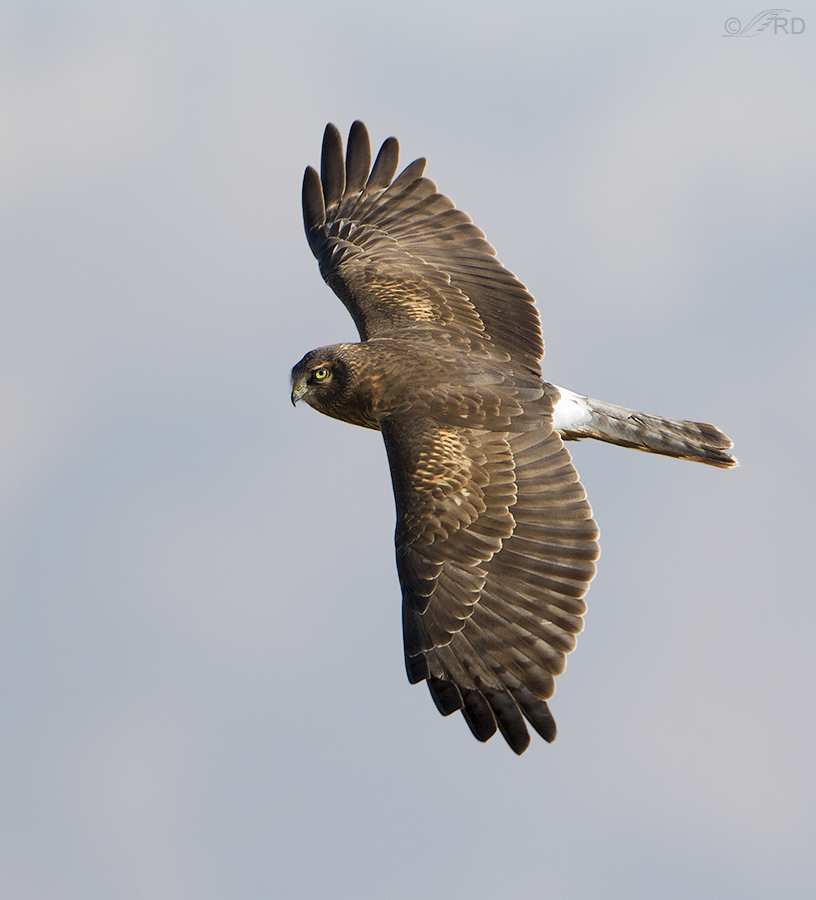Obtaining proper exposure on certain birds with high contrast colors has always been a big problem for bird photographers. When your subject has both very light and very dark colors it becomes problematic to get good detail in the darks without “blowing out” the whites, especially if the whites are very bright white. A partial list of bird species that are notoriously difficult to expose properly would include the Black Billed Magpie, male Wood Duck, adult Bald Eagle and many species of Terns. And because of the bright white rump patch found on all ages and both sexes of Northern Harriers, that species would also be on the list.
One of the partial solutions to this problem is to photograph while the sun is low during either early morning or late afternoon because the light is much less “harsh” then and also because it has a better chance of striking the bird obliquely rather than at right angles (light at an angle tends to produce tiny texture shadows – “detail”).

1/2000, f/6.3, ISO 500, 500 f/4, 1.4 tc, natural light, not baited, set up or called in
- the well-lit and detailed view of the topside of a harrier in flight, provided by the banking flight posture of the bird
- getting good eye contact with this flight posture isn’t easy, but this shot has it
- the background has some color texture – instead of solid blue sky or white clouds it’s a subtle mixture of both
- the harrier is sharp – always a challenge with birds in flight
But this shot was taken in late morning when the sun was fairly high so the light is a bit harsh and that white rump patch is “aimed” directly toward the sun, so the rump patch whites were too bright (slightly above 255 in a threshold layer for us Photoshop geeks) in the original RAW file.
This meant I had to do something I normally try to avoid – selective processing to bring the whites down just enough, without damaging image quality significantly. In the final product the whites are much improved and very few pixels are too bright (above 255), even though there’s still not a lot of detail where the whites meet the back of the bird.
One of the primary rules of good bird photography is to get the best exposure you possibly can “in camera”, rather than trying to “photoshop” your way out of an exposure mistake. In this case it wasn’t really a mistake, just a very difficult exposure to make in the first place. And I liked the image well enough to “play” with it a little.
Ron


Love the image Ron. The quality is equally as striking as the subject you attempt to capture. Masterful coins it best.
I’m glad you like it, Bryce. Me too, but a decent shot of a kestrel in flight was sure a long time coming…
A joy and a delight. Thank you.
Thank’s, Elephant’s Child.
Beautifully photographed and thanks for the valuable information!
Harriers are one of my favourite raptors, probably because they are also very elusive! LOL!
It seems my favourite birds are invariably the ones I haven’t photographed!
You’re right, Chuck – harriers ARE elusive. And frustrating.
I always like to see photos of birds backs in flight . It revrals there shape as to how they catch the wind like planes and jets . I also like it because I feel I as a viewer to this event am flying with them ,not on the ground looking up.
In painting a large canvas using bird flight this angle of above the bird looking down has great effect . The viewer to the painting now is slightly dis oreinted ,a positive thing . This keeps the art work from getting sentimental about birds ,something that does not happen when photographing birds ,especially when you are taking the photo.
Thank you for the perspective of an artist on this type of image, Eldridge. Very interesting.